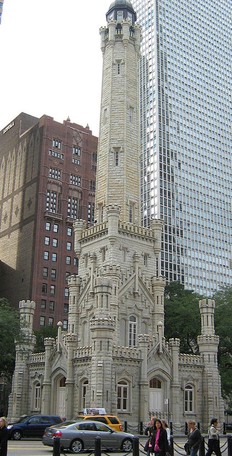Chicago Water Tower
Introduction
Text-to-speech Audio
Images

Backstory and Context
Text-to-speech Audio
By the 1860s, there was a significant strain on Chicago’s water supply. Because the nearshore water of Lake Michigan was too polluted for safe use, in 1867 engineer Ellis S. Chesbrough created a water-supply tunnel system that ran two miles off shore. A pumping station was required to transport the water such a distance. In 1869, a more consistent pumping system was needed, so a standpipe system was designed and the famous Water Tower was constructed to house the system. Architect William Boyington designed the building almost entirely with Joliet limestone in his famous castellated Gothic Revival style. In 1882 during a visit to Chicago, Oscar Wilde famously remarked that the tower was a “castellated monstrosity with pepper-boxes stuck all over it.”
Because of the Water Tower being constructed primarily of stone, it became one of the few buildings to survive the Great Fire of 1871. During the fire, German immigrant Frank Trautman covered the tower with blankets and old ship sails and kept them wet in an effort to protect the building. Because such a grand building remained upright after the fire, it became a symbol of determination for the city.
The building underwent two renovations during the 20th-century, first between 1913-1916 and the second during 1978. The Water Tower is now an art gallery for the Chicago Office of Tourism and was added to the National Register of Historic Places on April 23, 1975.Sources
Osmond, Lynn J. Chicago Water Tower. Encyclopaedia Britannica. January 23, 2019. https://www.britannica.com/place/Chicago-Water-Tower.
